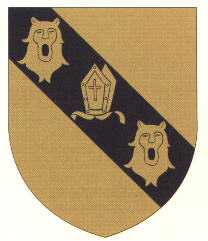Gomiécourt: Difference between revisions
Jump to navigation
Jump to search
Knorrepoes (talk | contribs) m (Text replace - "Armorial de France, Armoires, Blason" to "Armorial de France, Armoiries, Blason, Héraldique, Armes") |
Knorrepoes (talk | contribs) m (Text replace - "[[Literature" to "{{media}} [[Literature") |
||
| Line 11: | Line 11: | ||
====Origin/meaning==== | ====Origin/meaning==== | ||
The bend in the arms is derived from the arms of the Lords of Gomiécourt. The mitre is a symbol for the Bishops of Arras, who had an estate in the municipality. The two lion heads are derived from the arms of the Carnin family, who, in the 18<sup>th</sup> century, also acquired several possessions in the village. | The bend in the arms is derived from the arms of the Lords of Gomiécourt. The mitre is a symbol for the Bishops of Arras, who had an estate in the municipality. The two lion heads are derived from the arms of the Carnin family, who, in the 18<sup>th</sup> century, also acquired several possessions in the village. | ||
{{media}} | |||
[[Literature]] : Bouchet et al, 1994 | [[Literature]] : Bouchet et al, 1994 | ||
Revision as of 22:01, 8 July 2014
| Heraldry of the World Civic heraldry of France - Armorial de France |
GOMIÉCOURT
Département : Pas-de-Calais
Origin/meaning
The bend in the arms is derived from the arms of the Lords of Gomiécourt. The mitre is a symbol for the Bishops of Arras, who had an estate in the municipality. The two lion heads are derived from the arms of the Carnin family, who, in the 18th century, also acquired several possessions in the village.
Contact and Support
Partners:
Your logo here ?
Contact us
© since 1995, Heraldry of the World, Ralf Hartemink 
Index of the site
Literature : Bouchet et al, 1994











